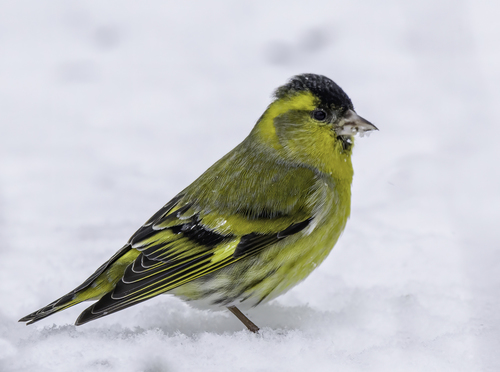
Eurasian Siskin
The Eurasian Siskin (*Spinus spinus*) is a small, vibrant finch known for its striking yellow and black plumage and lively, acrobatic behavior. It plays a crucial role in seed dispersal within its native coniferous and mixed woodland habitats across Europe and Asia. While not typically considered culturally significant in the same way as some larger or more iconic birds, the siskin's cheerful presence and association with winter landscapes make it a welcome sight for birdwatchers. Its fluctuating populations, often tied to seed crop availability, highlight the interconnectedness of forest ecosystems.
11-12.5 cm
Length
20-23 cm
Wingspan
Least Concern
Conservation Status
Distribution
The Eurasian Siskin breeds across a vast area of Europe and Asia, from Ireland and Great Britain in the west to eastern Siberia and Japan. Its winter range extends further south, reaching North Africa, the Middle East, and parts of China. It exhibits irruptive migrations, with large numbers moving south in some years and remaining further north in others, depending on food availability. Altitudinal range varies, found in lowlands to montane forests.
Lifespan
Typically 2-3 years in the wild, but can live up to 8 years in captivity.
Eurasian Siskin's Habitat
Habitat Types
Coniferous forests, Mixed woodlands, Birch forests, Alder thickets, Parks and gardens (during winter)
Climate Zones
Temperate, Boreal, Subarctic
Adaptations
Siskins possess a fine, pointed bill perfectly adapted for extracting seeds from cones and catkins. Their agile feet allow them to cling to branches upside down while feeding.
Variations
While no formally recognized subspecies exist, slight variations in plumage brightness and size have been observed across the siskin's extensive range. Further research is needed to determine if these represent distinct populations.
Appearance
Breeding Plumage
Males are brighter in breeding plumage, with a more intense yellow-green body, a black cap, and a small black bib. Females and non-breeding males are duller, with streaked underparts and a less distinct cap.
Seasonal Feather Changes
Plumage becomes slightly duller after the breeding season due to feather wear.
Sex Based Plumage Differences
Males are more brightly colored than females, particularly on the head and breast.
Notable Features
Black cap and small black bib (more prominent in males), Yellow wing bars and rump, Forked tail, Streaked flanks
Diet and Feeding
Primary Foods
Seeds (especially from conifers, alder, and birch), Insects (mainly during breeding season), Buds, Berries (occasionally)
Foraging Behavior
Siskins are highly active foragers, often seen hanging upside down from branches to reach cones and catkins. They form flocks, especially in winter, and move erratically in search of food.
Specializations
Their slender, pointed bill is specialized for extracting seeds from cones and other small, enclosed food sources.
Seasonal Diet Variations
Diet shifts significantly with the seasons. Insects are crucial for feeding young during the breeding season, while seeds form the bulk of the diet in autumn and winter.
Behavior
Social Structure
Highly social, especially outside the breeding season, forming large, noisy flocks. During breeding, they are more territorial, but often nest in loose colonies.
Communication
A constant, twittering 'tsu-tsoo-tsoo' call, A more melodic song used during courtship and territorial defense, Contact calls within flocks
Migration
Siskins are partially migratory, with some populations undertaking long-distance movements. Others are irruptive migrants, moving in large numbers in response to food shortages.
Territorial or Group Behaviors
Males defend a small territory around the nest during breeding. Outside of breeding, they are highly gregarious and form large foraging flocks.
Conservation
Threats
Habitat loss (due to deforestation and changes in forestry practices), Climate change (affecting seed availability and timing of breeding), Pesticide use (reducing insect prey during breeding season), Trapping (in some regions, although illegal in many)
Protection Programs
Habitat restoration and sustainable forestry initiatives, Monitoring of population trends, Legal protection under various national and international laws (e.g., EU Birds Directive)
Local National Laws
Protected under wildlife laws in many European countries.
Population Trend
Fluctuating, but generally considered stable.
Population Estimates
The global population is estimated to be between 30,000,000 and 59,999,999 mature individuals.
Interesting Facts
Siskins are known for their irruptive migrations.
These unpredictable movements are driven by fluctuations in seed crops, leading to large numbers appearing in some areas one year and being absent the next.
They are highly acrobatic feeders.
Often seen hanging upside down to extract seeds from cones and catkins.
They readily visit garden bird feeders.
Especially in winter, they are attracted to feeders offering niger seeds and sunflower hearts.
They are among the smallest finches in Europe.
Making them easily identifiable by their size, along with their distinctive plumage.
Faqs about Eurasian Siskin
What do Eurasian Siskins eat?
They primarily eat seeds, especially from conifer, alder, and birch trees. They also eat insects, particularly during the breeding season.
Where do Eurasian Siskins live?
They breed in coniferous and mixed woodlands across Europe and Asia. In winter, they can also be found in parks, gardens, and other areas with suitable food sources.
Are Eurasian Siskins endangered?
No, they are classified as Least Concern by the IUCN. However, their populations can fluctuate significantly depending on food availability.
How can I attract Eurasian Siskins to my garden?
Provide niger seeds, sunflower hearts, and other small seeds in bird feeders. Planting trees like alder and birch can also help attract them.
Do Eurasian Siskins migrate?
Yes, they are partially migratory. Some populations undertake long-distance migrations, while others are irruptive migrants, moving in large numbers in response to food availability.
Copyright @ Nature Style Limited. All Rights Reserved.
 English
English